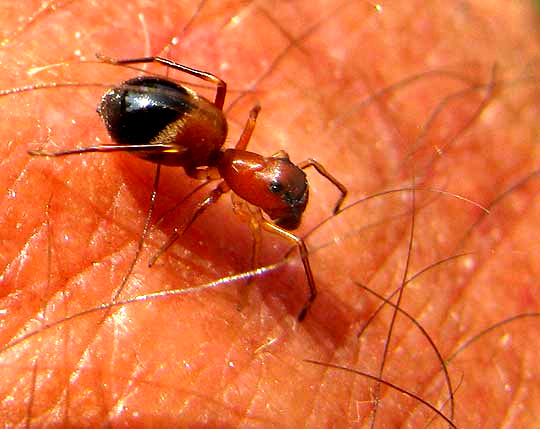Excerpts from Jim Conrad's
Naturalist Newsletter

from the May 5, 2013 Newsletter issued from the Frio Canyon Nature Education Center in northern Uvalde County, southwestern Texas, on the southern border of the Edwards Plateau; elevation ~1750m (~5750 ft); N29.62°, W99.86°; USA
ANT MIMICKING SPIDER
The ant navigating among my arm's hairs caught my attention with its black-and-red abdomen. In general, ants aren't two-colored. Also, the shape wasn't quite right. Not being able to see too well and suspecting something interesting here, I snapped the picture shown below.

The moment that image came onto my laptop monitor I knew that my ant wasn't an ant, if for no other reason than that it had eight legs, and therefore wasn't even an insect. It's an ant-mimicking spider. The picture at the top of this page takes a closer look at the head region -- the cephalothorax -- making the point better.
With a little creative search-engine use on the keywords "ant mimicking spider texas" I was able to match my pictures with other pictures with their critters named Peckhamia americana...
*UPDATE: However, this time the picture-matching approach didn't work so well. in 2024, with many more identification resources on the Internet, when I uploaded this page's pictures to the iNaturalist website, jumping-spider enthusiast and user "calebcam" disagreed with our ID, and suggested the jumping spider genus Sarinda.
When I did a new search on Sarinda species found in Texas, our pictures matched images identified as SARINDA HENTZI, occurring throughout most of the eastern and south-central US, south into southern Texas,, and possibly into Mexico. Though this species appears on many lists as present, not much information is available about its life cycle or ecology.
Last December we profiled the Texas Bow-legged Bug, which was an ant mimicking bug (http://www.backyardnature.net/n/a/bow-leg.htm ) and now here's another ant mimicker. If there's a lesson here, I suppose it's that you can cut down on the number of predators chasing you -- or sneak up more easily on your own prey -- if you look like an ant.